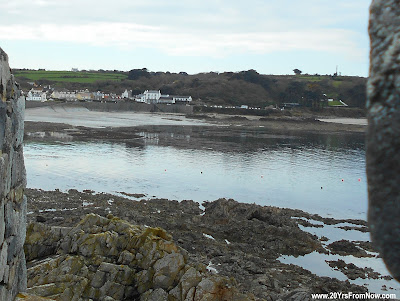Considering Guernsey's rugged coastline and strategic location between France and England it's not surprising a good number of ships have perished on its shores. Fort Grey and the Shipwreck Museum pays homage to those ships and their crews.
The fort is on an island on Guernsey's south shore and accessible by foot during low tide.
It stands on the site of an earlier smaller castle known as Chateau de Rocqaine.
In 1803 the remains of the castle were demolished and replaced with a battery capable of containing 12 to 14 guns. The protective outer wall is ten feet thick and the new fort was named in honour of Guernsey's Governor (1797-1807) General Charles, Earl Grey of Howick. Due to its inner white tower and outer grey ring the locals call Fort Grey the 'cup and saucer'.
Tickets are purchased opposite the fort (on the mainland) and the remains of one of the first recorded ships that sunk in Guernsey waters is housed there. This Roman merchant ship sunk around 280 AD in St. Peter Port harbour after it had a fire on board. The oak hull is now preserved in a temporary airtight room (much like Henry VIII's Mary Rose in Portsmouth).
Prior to its demise it carried products from Algeria, Spain, France to England and Ireland. At least five other Roman vessels are known to have perished near Guernsey.
Back on Fort Grey proper one can see the reason this site was chosen. It offers a commanding view of the sea and any vessel that dares make an approach.
During WWII Fort Grey (and Guernsey itself) was occupied by the Germans. This is an illustration from a 1943 German report on the island's fortifications.
Inside the tower (on the lower level) the museum pays homage to lives lost and rescued as well as all the Guernsey citizens who died on the Titanic's maiden voyage.
The upper level offers glimpses into the lives of the lighthouse keepers as well as the history of the lighthouse (which was surprisingly a very late addition to the coast).
The storyboards on the right lists some of the ships sunk in Guernsey's waters including a Canadian vessel. Other vital statistics includes the insurance agent, the value and list of the goods on board, as well as what if anything was selvaged. Local fishermen often made valiant attempts to rescue the crew and were recognized and rewarded for their bravery with a few coins.
Next stop was the German Occupation Museum. The island was occupied for five years (1940-1945) and the exhibits include machinery, guns, field equipment, medical instruments, personal letters and memorabilia.
It also tells the story of two fishermen who made a daring escape in 1943 to England. They made the treacherous journey in this boat named Kate. Fearing others would make similar attempts to escape the Germans banned all fishing.
This caused a great deal of hardship for locals and Germans alike and food became scarce. These canned goods from Canada helped fill the void and ward off starvation.
My favourite item on display was this Enigma Machine. (Yeah, Alan Turing!)
We returned home to spent the evening with Ralph and are very grateful to have neither experienced a shipwreck nor an occupation. We think Ralph's pretty happy, too!
* * *





















